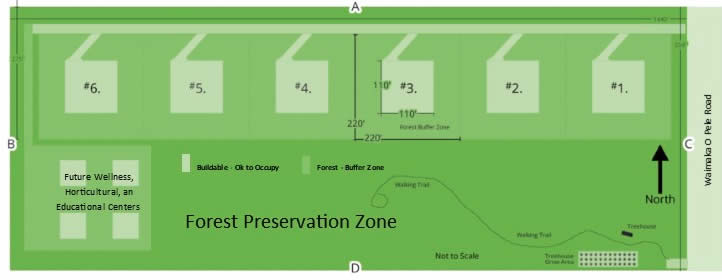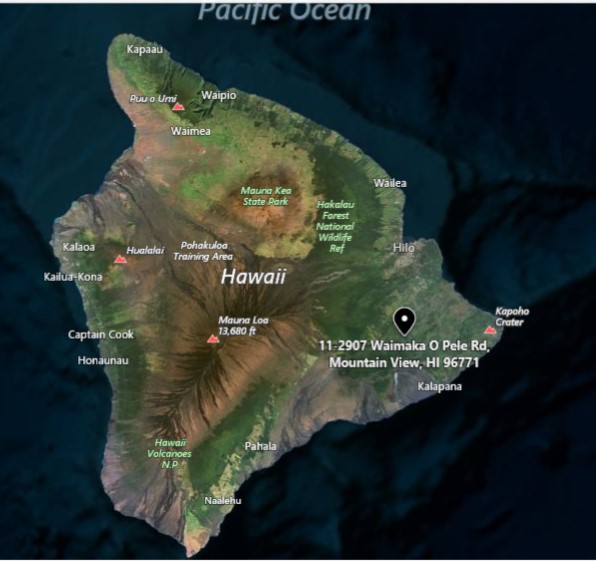Aloha ʻĀina; love for the land and its people.
Aloha ʻĀina at the treehouse is an in-depth, cultural and personal relationship with the land and people.
We honor this native ‘Ōhi‘a forest. Located in ahupuaa Waikahekahe adjacent to the Wao O Kele O Puna watershed we want to share with you a spirit of oneness with this environment. We want you to feel a special serenity, a calmness and peace. Certain spaces we visit in Hawaii have been imbued with thousands of years of prayer, chants and worship. We have prayed towards four deities and the spirits in our trees for two short decades. Yet people who come here say they feel a connection to this forest.
Our reverence for Kāne, responsible for medicinal plants and trees is steeped in gratitude. Our gratitude for the safety we feel here is kindled through our praise for Kū. We give thanks to Lono for the overwhelming feeling of abundance we feel and experience when we listen. Kanaloa tempers our souls and the wildness of the land and sky with our needs for life, continuity, and courage. We are grateful for these life experiences. Making decisions based on our core beliefs has evolved our own awareness of these deities.
We want to share with you this feeling of Aloha ʻĀina.
Our ethos includes the need and action necessary to improve the well-being of Hawaiʻi. We welcome pillars in our communities to help bring peace to all places we gather. In this spirit we encourage and foster practices of Aloha ʻĀina.
You can participate. A good starting point is to simply ask for entry. An ancient practice in Hawaiʻi, is asking for entrance to a place, like this forest. Cultural practitioners may ask for entrance to places for many reasons. To worship, to ask for forgiveness, to hunt and to gather. These activities have their own protocols. In asking, a guide may appear in the form of a native bird for example. A bird may lead one using their sound to the food and medicine they need. Equally important is your ability to listen. Similarly, we hope you heard a calling and have been lead here.
If you wish to enter the forest and ask for entrance you can simply state your name, your intentions and ask for entrance. Upon exiting gratitude is offered. These simple acts can have a lasting and profound effect on you as you visit other places in Hawaiʻi. This may be unfamiliar but you can use your own words. Or you can ask for help through chant.
E Hoe Mai is a chant taught in our schools that you can chant easily.
E hō mai
Ka ʻike mai luna mai ē
ʻO nā mea huna noʻeau
O nā mele ē
E hō mai
E hō mai
E hō mai
This verse is repeated three times, with each repetition raising the pitch.
Translation:
Grant us knowledge from above
The things of knowledge hidden in the chants
Grant us
Grant us
Grant us
Our love for the land is eternal. Our allegiance to ka lāhui Hawaiʻi and moku o keawe (Hawaiʻi Island) extend outwards to ka pae ʻāina o Hawaiʻi (Hawaiʻi Islands – also see). We honor and develop a culture of the land on which we live in the hope that we can all experience peace and abundance on Earth.
According to Peter Young, “Most people would agree that these gathering principles embody appropriate treatment of those we love and respect. For example, when we enter the home of a friend today, we usually ask permission; we try not to impose on their hospitality or damage their home.”
“So it was that Hawaiians approached gathering from native ecosystems – good manners and plain common sense guided their behavior.” (Anderson-Fung and Maly)
Your traditions are also welcome here. Human beliefs are plentiful and our practices varied. Yet, it is our individual acts of love, allowance, forgiveness and awareness that bring us all closer together. The Treehouse Farm is a place where you can be yourself.
Details and land development. In the eighties, land developers drove bulldozers into Wao O Kele slicing the land and trees like three rungs in a ladder. Markers identified 109 separate lots. During the first ten years the forest was left relatively untouched. A bulldozer had cleared a space large enough for a few cars. A neighbor used his farm tractor to help level out a driveway. Instead of using a large bulldozer for a house pad, we built a trail by hand. For three months I walked this trail. Then as predicted by a friend, the trees whispered, this is the place. I took about ten steps off the trail and found a large mound. Some geologists call this a timulene. It’s a large rock formation upon which we set one side of our home in the trees.
Malama i ka Aina is to care for the land. Removing invasive species is routine and daily. When I use “we” I am referring to the people who have come and gone and those who help periodically and in the present. “We” now includes “you” as your stay here makes you part of our ʻohana (family).
When you enjoy other places in Hawaiʻi notice the consistency in the silent messages of Aloha ʻĀina. Be mindful of Kapu.
Kapu simply means not allowed. For example, you may see “Kapu” instead of “No Trespass” to mark so-called, private property. Kapu Aloha calls on each of us to be pillars or our best selves. We air and resolve grievances in Kapu Aloha. Kiʻai or protectors of the land and water practice vigilance in pursuit and practice of kapu aloha. Allowances are made for Hoʻoponopono or a righting of wrongs. It is how issues get resolved in Hawaiʻi.
We deeply appreciate your visit. Everyone who comes to the treehouse does so for a reason. Most do not know the reason until they return to their home. You may realize why you are here while visiting. Your mindfulness is welcome and will help guide your thoughts and actions.
Our future plans include land leases that would accommodate a tiny community. There are no plans to sell the property or create a large development. We help others learn how they can live on the land without harming or desecrating the land. Our goal is to demonstrate that anyone can do what we did and live here in harmony with nature.
Additional Details
Location: Wao o Kele Puna District, Mountain View, Hawaiʻi
Size: 20 acres, AG3, 550×1440
Vegetation: Native ʻŌhiʻa Forest, Hāpuʻu pulu tree ferns, Uluhe ferns
Climate: One of the rainiest places on Earth. 200″ per year annually. We love rain.
Soil: Volcanic rock with about 2 inches of topsoil.
Occupancy: Fixed-term land leases.
Optional Private Growing Areas with Cultivators on Site

